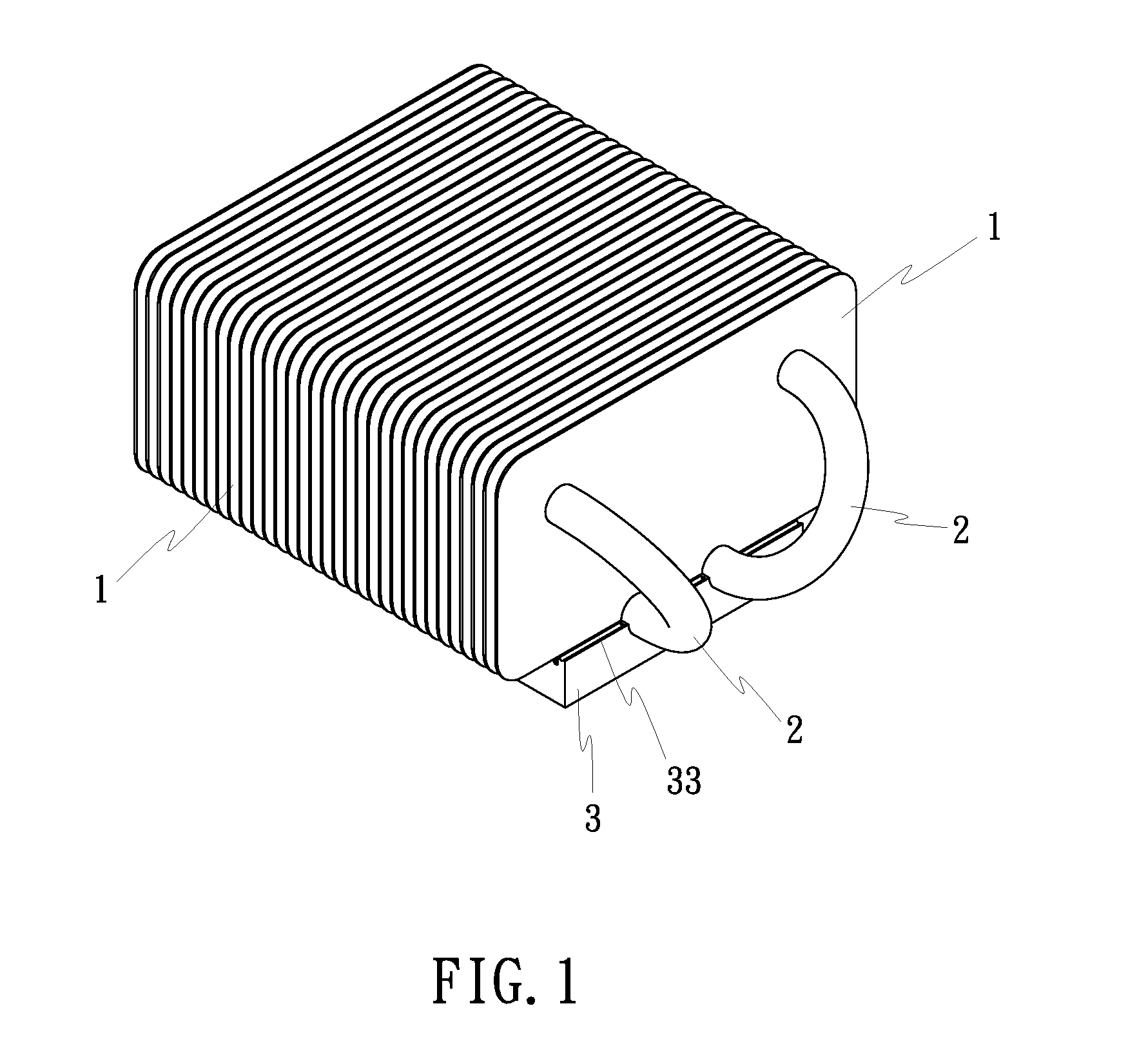Cooler device
- Summary
- Abstract
- Description
- Claims
- Application Information
AI Technical Summary
Benefits of technology
Problems solved by technology
Method used
Image
Examples
first embodiment
[0029]Referring to FIGS. 1˜5, a cooler device in accordance with the present invention is shown comprised of a set of radiation fins 1, a plurality of heat tubes 2, and a base member 3.
[0030]The radiation fins 1 have same or different shapes, and are arranged in parallel. Further, each radiation fin 1 has a plurality of backwardly curved and crimped bottom mounting portion 11 (see FIGS. 4 and 5).
[0031]The heat tubes 2 are double closed-end U-tubes filed with a working fluid (not shown) and fixedly fastened to the radiation fins 1 to keep the radiation fins 1 in parallel.
[0032]The base member 3 is a solid flat metal block extruded from aluminum or copper, having two longitudinal positioning grooves 31 (of semicircular cross section) formed on the top wall and respectively fitting under the periphery of a part of each of the heat tubes 2, a plurality of deep transverse locating grooves 32 formed on the top wall and adapted to receive the backwardly curved and crimped bottom mounting p...
second embodiment
[0034]FIGS. 6 and 7 show a cooler device in accordance with the present invention. According to this design, the cooler device is comprised of a set of radiation fins 1, and a base member 3.
[0035]The radiation fins 1 each have a plurality of hooked portions 12 protruded from one side, namely, the top side, and a plurality of backwardly curved and crimped bottom mounting portions 11. Further, the radiation fins 1 are flat metal sheet members of same or different contours. By means of hooking the hooked portions 12 of one radiation fin 1 to another, the radiation fins 1 are fastened together in a parallel manner.
[0036]The base member 3 is a solid flat metal block extruded from aluminum or copper, having a plurality of deep transverse locating grooves 32 formed on the top wall and adapted to receive the backwardly curved and crimped bottom mounting portions 11 of the radiation fins 1, and a plurality of shadow transverse grooves 33 formed on the top wall between each two adjacent trans...
third embodiment
[0040]FIG. 16 shows a cooler device in accordance with the present invention. According to this embodiment, the cooler device is comprised of a base member 3a and a plurality of radiation fins 1. The base member 3a is a metal cylinder having a plurality of deep transverse mounting grooves extending along the length and alternatively arranged in parallel around the periphery. The backwardly curved and crimped bottom mounting portions (not shown) of the radiation fins 1 are respectively fastened to the deep transverse mounting grooves of the base member 3a.
PUM
 Login to View More
Login to View More Abstract
Description
Claims
Application Information
 Login to View More
Login to View More - R&D
- Intellectual Property
- Life Sciences
- Materials
- Tech Scout
- Unparalleled Data Quality
- Higher Quality Content
- 60% Fewer Hallucinations
Browse by: Latest US Patents, China's latest patents, Technical Efficacy Thesaurus, Application Domain, Technology Topic, Popular Technical Reports.
© 2025 PatSnap. All rights reserved.Legal|Privacy policy|Modern Slavery Act Transparency Statement|Sitemap|About US| Contact US: help@patsnap.com



